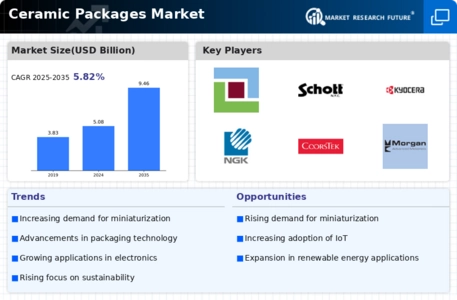Market Share
Ceramic Package Market Share Analysis
The Ceramic Packages market, a crucial segment in the electronics and semiconductor industry, implements a variety of market share positioning strategies to navigate the competitive landscape effectively. A foundational strategy revolves around technology and material innovation. Companies in the Ceramic Packages market invest significantly in research and development to advance the design and performance of their ceramic packaging solutions. By introducing cutting-edge technologies, such as advanced thermal management, improved electrical insulation, and miniaturization features, these companies distinguish themselves in the market, attracting clients seeking high-performance and reliable ceramic packages for their electronic components.
Cost leadership is another pivotal strategy employed by Ceramic Packages manufacturers to gain a competitive advantage. Through optimizing manufacturing processes, achieving economies of scale, and strategic sourcing of materials, companies can lower production costs. This cost efficiency allows them to offer competitive pricing for their ceramic packages, making them more appealing to cost-conscious customers across various industries. Cost leadership is particularly crucial in the semiconductor sector, where price considerations significantly influence purchasing decisions, and companies that can provide reliable and cost-effective ceramic packaging solutions position themselves favorably.
Market segmentation plays a crucial role in the market share positioning of Ceramic Packages manufacturers. Recognizing the diverse needs of different industries, such as telecommunications, automotive, and aerospace, companies tailor their ceramic packaging solutions to specific requirements. For example, the packaging needs for automotive sensors may differ significantly from those for aerospace applications. This strategic segmentation allows companies to effectively penetrate multiple markets, addressing the unique packaging demands of each segment and solidifying their presence in various industrial sectors.
Geographical expansion is another key aspect of market share positioning in the Ceramic Packages market. Companies strategically expand their operations to key markets where industrial activities and demand for ceramic packages are high. This expansion may involve establishing production facilities, creating distribution networks, or forming partnerships with local entities. By positioning themselves strategically in regions with robust demand for Ceramic Packages, companies can tap into new customer bases and adapt to regional variations in electronic component manufacturing practices, contributing to overall market share growth.
Furthermore, a commitment to quality and reliability is paramount in the Ceramic Packages market. Companies focus on developing ceramic packages that meet stringent industry standards, ensuring the protection and longevity of electronic components. The reliability and durability of ceramic packages are critical factors in the semiconductor industry, where electronic devices often operate in demanding environments. Ensuring the highest quality standards not only establishes the reputation of a company but also fosters trust among clients, contributing to long-term relationships and sustained market share.









Leave a Comment